←pindari glacier | | nainital route notes
To Munsiyari, or not
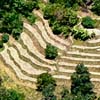
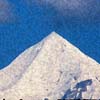
|
We climbed through sparse forests of giant trees and occasional cleared terraces. It was awfully quiet and there weren’t any teashops. I had somehow imagined the climb to be 500m, and heavens knows how this figure had plopped into my mind, but it wasn’t until after about 1000m that we reached a pass. Thus our dreamy plans began to harden into reality and a cold impossibility.
When we crossed the ridge we came to a marvellous expansive view of an undreamt of valley; and above all this a panorama of Nanda Kot, and Panchchuli. The main peak in the latter ridge is a stunning perfect pyramid of white, but it doesn’t seem to have its own name. The road dropped a little and climbed back up, threading in and out of the crest. We’d hoped to be in Shama or Tejam for lunch but given up on that long ago; instead found a small lodge at a place a few km before. Birthi was out; we stopped here; we had a day in hand so it wouldn’t matter to allow another day to Birthi.
We breakfasted in Shama, spectacularly sited in the dip of the pass, where a man warned us the Birthi road was dangerous. He didn’t say impossible. We set off, and on the way asked some other men, they gestured hairpin bends, which we reckoned might appear dangerous to some, but not of course to us. We dropped into a valley fronting a prodigally picturesque view of an infinity of backlit mountainous ridges; although we were looking away from the main highest range, even the lesser foothills are a wild maze of torn up and fantasial landscape.
The road veered round to the right taking us to the Ram Ganga valley and above another huge drop. The road was narrow and carved into the folds of the hillsides. We could see a road on the opposite side, lower down but we didn’t see any traffic. Neither was there any traffic on our road, but it was Diwali and we imagined most people were intently involved in sweets and fireworks. We lost about 1000m, and as we lost more and more precious height, the road became narrower and more beat up, and perhaps you would call it dangerous in parts.
Then we came round a bend and saw the landslide. A vast mass of gravel and rock had obliterated a section of the road. Half a dozen goats were picking about on the nearside, but there wasn’t anything visible you would call a path. We stood for a while reading in the horror of it, and retreated. We wondered if there had been some sort of detour but there wasn’t. We climbed back up the 1000m and returned all the way to Bageshwar.
Diwali
We weren’t exactly looking forward to Bageshwar but we’d had enough of Kapkot and the other place. But Bageshwar does have really quite a decent hotel, and it’s on the river, and it has balconies, so the Diwali noisefest we’d anticipated was soothed by the sound of river-running water, and we were treated to an evening of thousand splendid firework displays.
What to do next was a difficult choice. It was hard to give up on the plan to go to Munsiyari and the last of the mountains, but we didn’t know if which roads might be open, and if we were to try we would have to use a car part of way there as riding there and back looked too long. This isn’t an area where there are enough foreign tourists for the taxi drivers to find it worthwhile to learn much English; it would have meant leaving too much to luck. It’s possible the only road open would have been along the Gauri Ganga valley. We spent the last few days, then, riding out of the mountains to Nainital. The ride had some pleasures; we rode along for a while with Neeraj from Bageshwar. The roads never cease to be up and down, but a little less fierce now; and more busy, but there are better hotels.
We ran into another European cyclist here, Heinrich. I had seen a German bike in Pipalkoti when we steamed though on our third day out but we’d descended several metres in the time it had taken my brain to process the information. Heinrich was one of these people that spends half his life on a bike in Asia and it surprised us when he said we were the only European cyclists he’d seen. Heinrich was off to visit some 100 year old swamis. We didn’t admit that we were headed for the Imperial, lest he think us slightly odd.
Jageshwar
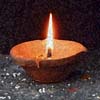
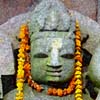
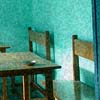
|
Further down is the main group. You see the village first, a stack of guesthouses piling up the slopes. The Pilgrim Lodge was the most immediately attractive, a delightful historic bungalow with a verandah strewn with climbing roses and marigolds. It’s run by the equally delightful Mr Daniels, whose grandfather was British but married and lived here; the guesthouse is still owned by the Chands, the dynasty that centuries ago had ruled here and had established the temple style.
The temples stand in a shady courtyard deep in the forest valley. It’s a mysterious spot, shady and damp, the grouping seems almost random, the little chambers huddle together conspiratorially, the interiors, lost into the sunless and smoke-soot blackness evoke a sense of ancient mysteries. The larger shrines have idols garlanded with glittery shiny treasures and offerings, in the smaller shrines the lingams are scattered with bright marigold petals, or perhaps a single flame of an oil lamp burns on the threshold.
We had two days left of cycling, an a busier and landslide-damaged road. The ride was almost tolerable, and we made sure we did enough climbing to take our total to 20km. There are not many great places to stay but we found a peaceful enough spot at Garam Pani; and finally at Nainital, which is heavingly busy with Indian tourists, there are plenty of fancy hotels. We booked ourselves a car, whose driver’s indefatigable good humour made up for the ruinous state of the tyres, and made it to the Imperial in time for dinner.